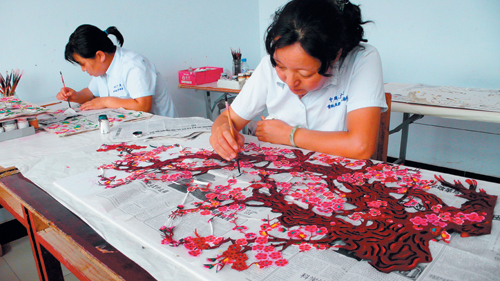Folk Paper-cut

Two workers engrave paper-cut works [Photo provided to shanxi.chinadaily.com.cn/datong]
Datong city enjoy a long history of folk paper-cutting, which can be traced back to the Ming and Qing dynasties(1368-1911).
It initially became popular in the Guangling, Lingqiu, and Yuxian regions. The only tool needed was scissors. Most works were of birds, animals, fish, insects, flowers and plants.
Then, the paper-cut industry gradually developed. After a long time, skills were highly improved, and the tools were modified. Scissors were replaced by an engraving knife.
The contents also turned more complicated, adding legendary stories, Chinese opera facial make-ups, historical figures, ladies in ancient costume, Buddhist and Taoist gods and historical sites.
Paper-cutting artists are becoming more professional and more distinguishable from amateurs, with works featuring novel compositions, vivid images, graceful figures, delicate carvings and bright colors.
Many artists would sell their works in street markets on every twelfth lunar month, in a form of a paper-cutting exhibition. Visitors can feast their eyes on this beautiful art. Local people will buy the paper-cuts to paste on their doors or windows for good luck at every festival, while for visitors, they make good presents.
Now, the popularity of the folk art has been expanded from the initial three counties to the entire city as well as other provinces or cities. The number of practitioners, including folk artists, has also increased.
The works are applied to broader areas such as the masthead design of newspapers and magazines, logo design and home decoration. The size of them have become larger, from a single piece to multiple pieces.
Cao Xiuyun, an art teacher of the Datong First Senior Vocational School, is the most renowned paper-cutting technician. She became engaged in the art at 15. During her career of more than two decades, her works have won numerous awards at exhibitions of national, provincial, and municipal level.
She donated her large-scale paper-cut work "Nice Soaring Dragons" to the Asian Games in 1989, and the 22-meter giant work "Flaming Wish" to the Chinese Olympic Games Bid Committee in 1993.
Cao's works boast four characteristics – striking appearance, close-knit structure, fine engraving and unique style.


